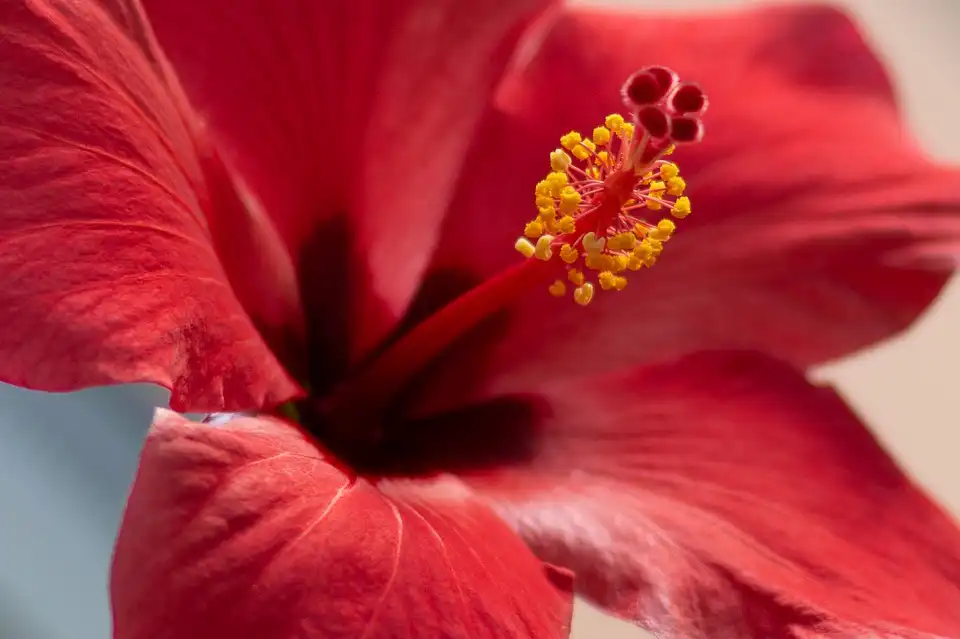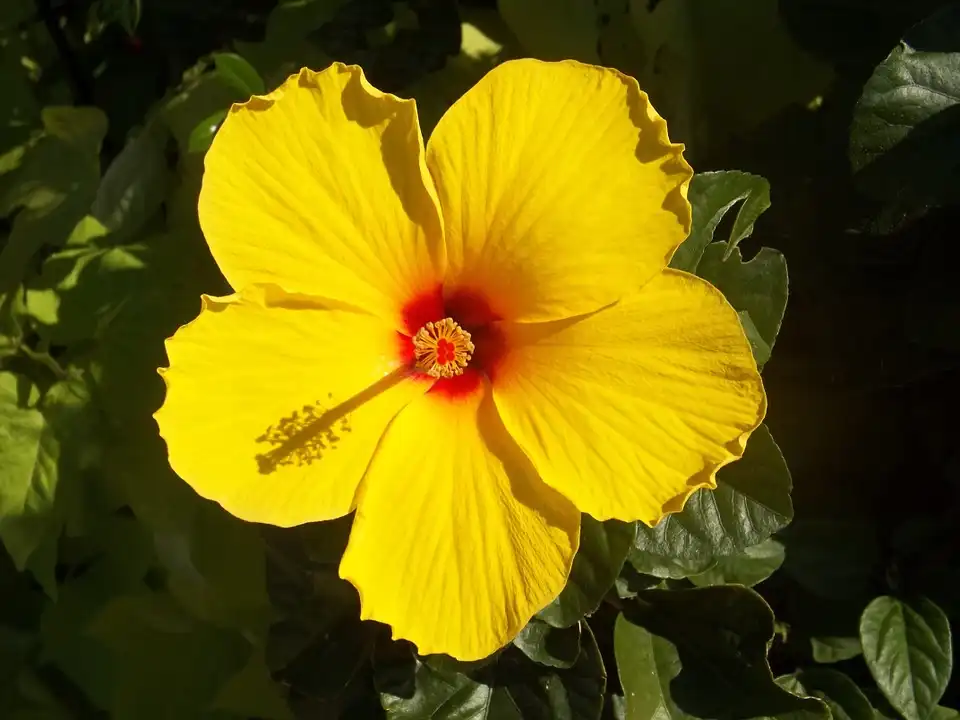How to Identify a Hibiscus
Hibiscus is a broad-spectrum genus of spectacular flowering shrubs, trees, and ground cover plants. The reason why I call it broad-spectrum is that within the genus, there are several hundred different species of flowers, each with its own unique identity. No two species are exactly alike, and some even look like they aren’t hibiscus at all.
In this article, we’ll explore a number of the different species, focussing on how to identify a hibiscus and its unique characteristics. By the end, I hope to have broadened your understanding of what hibiscus is, how it looks and why it holds such a special place in the hearts of bonsai alchemists and garden enthusiasts.
A Primal Need to Understand How to Identify a Hibiscus
The human mind is a beautiful concept. It’s constantly working to piece together fragments of information and external stimuli to create a better understanding of its surroundings. In an attempt to understand its world, the human mind observes, records, and categorizes everything it comes in contact with. We are so skilled at noticing the differences between any number of objects, situations, and experiences.
We can decipher their core differences and place them into categories to make them easier for ourselves to understand. We even go as far as to attribute differences in something’s nature to differences in its native environment, purpose, understanding of the world, and living conditions.
One widely accepted reason for this is survival. Early on in human evolution, we needed to be able to tell the difference between predator and prey. We took note of these differences and still use them today to identify possible threats to our well-being. This survival instinct has evolved one-hundred-fold since, and now we can compute the most minute differences that exist in our world.
Being so genetically and evolutionarily predisposed to notice differences and categorize ourselves, each other, and the world at large into different groups has not always been the blessing it sounds like. We’ve created borders where nature didn’t deem them necessary, both physically and otherwise. But the benefits of this gift for categorization we have are clearly seen in the natural world and how we’ve been able to build such a vast understanding of the diversity that exists amongst plant kingdoms the world over. However, the more we learn, the more we realize how much we still have to learn. For this article, though, let’s focus on what we know about hibiscus.
Over time, experts and flora enthusiasts have come up with classification tools for the natural world. You’ll often come across words like clades, families, kingdoms, and genera while looking for information on a particular plant. All of these terms, however confusing, tell you some way that the plant is different from other plants.
Each one goes one level deeper into what separates biological life forms and what makes them completely unique. Still, it also gives you insight into how all life forms relate to each other and what characteristics they share. All of these words are a rank of taxonomy, and taxonomy is a truly beautiful thing.
Taxonomy is a branch of biology that classifies all living organisms. Without going into too much detail about the broader explanation of taxonomy which we’ll cover in a future article, let’s delve into what all these complex names mean when referring specifically to hibiscus. 
The Taxonomy of Hibiscus
The taxonomic system puts forth eight ranks called the taxonomic hierarchy that range from general to incredibly specific in their complexity. The eight ranks are as follows:
- Domain
- Kingdom
- Phylum
- Class
- Order
- Family
- Genus
- Species
Domain
Domain is the highest rank and is fairly new. Prior to 1990, the kingdom was the highest rank, but domain is slightly more specific. There are three domains, namely Bacteria, Archaea, and Eukaryota (also stylized as Eukarya). We know what bacteria is, and Archaea is just a fancy word for single-celled organisms. Eukaryota is a term to describe everything that isn’t bacteria or a single-celled organism. That is where we need to be.
Kingdom
From here, we can break the eukaryotic domain into its different kingdoms on our quest to understand hibiscus. There are three primary kingdoms, namely, Plantae, Animalia, and Fungi. A fourth kingdom exists to incorporate anything that falls under Eukarya but doesn’t fall under the three primary kingdoms; this kingdom is called Prostita. The three primary kingdoms are easy to understand if you look at their names; Plants, animals, and fungi. We now need to take a closer look at the plant kingdom, which requires breaking it up into its Phyla.
Phylum
There are theoretical and strongly-worded verbal wars between authors, botanists, and people in other scientific and creative disciplines over how many phyla should be officially recognized within the plant kingdom. Luckily, there’s only one that I’m interested in for the purpose of this article and the information within it; the Angiosperms. This is the phylum that hibiscus belongs to, and it’s a beautiful word of Greek origin. The first part of the word angiosperm comes from the Greek term angeíon (ἀγγεῖον), meaning vessel or bottle. The second part is from the Greek word spérma (σπέρμα), which means seed.
By breaking up its root words, we can infer that angiosperm has something to do with plants that bear seeds, but it means a little more than the words say. Angiosperm is the taxonomic name for all known flowering plant species that enclose their seeds within flowers, fruits, or berries. Fossilized remains suggest angiosperms have been around since the Triassic period in the earth’s history, so flowers are the thriving remnants of a world upon which we might never have complete clarity; the beginning of the age of the dinosaurs.
Class
We are now three degrees into the world of taxonomy. Next, we need to break the phylum Angiosperms up into smaller, more specific components. These components are known as classes, and there are eight of them that each give a more particular explanation of the plants they contain. The class we are most interested in concerning hibiscus is the Eudicots.
Eudicot is yet another complex word that exists to tell you more about where in the taxonomic hierarchy your plant fits. What it comes down to is that Eudicots typically have petals arranged in multiples of four or five. Flowers with petals arranged in fours are known as cruciform flowers, and those with five-petalled arrangements are called pentamerous flowers.
Eudicot feels like a word that doesn’t make much sense. It’s short for eudicotyledons, where ‘eu’ means true, and cotyledon means something with a hollow cup-like shape. Cotyledon is actually the name of the first two leaves that eudicots grow, and the connection with hollow cup-like shapes comes from these original leaves being part of the seed itself, and in some cases, the embryo of the plant. So here we have a word that altogether means a group of flowering plants that start out with two leaves that are part of their seeds or embryos. Within the Eudicot class or clade, there are different orders.
Order
The order we are most interested in is Malvales. If you try to read up on how to identify plants in this order, you’ll come across more complex terms that you may need to look up. I’ve done the hard work for you. You can identify Malvales in your own yard by looking at their leaves.
These leaves are described as having palmate venation. This is another term that looks incredibly superfluous to anyone not studying botany, but that is surprisingly easy to decipher if you look at the core words; Palm and vein. Palmate venation means that the leaves have numerous main veins apart from just one.
Usually, there are five veins, like the five fingers on your hand. Your fingers connect to your palm, just like palmate venation culminates at the base of the leaf. So palmate venation means plants that have leaves resembling human hands in their simplest form. This is another beautiful way that organisms often mimic each other.
Another explanation you’ll come across when trying to identify Malvales is the presence of a volvate calyx. Volvate here means a cup-like structure, and it comes from the Latin word volvere, which means to wrap. So here we have a good description of a cup-like structure that functions as a cover for some part of the plant. This volvate cover is called the calyx. The calyx is found at the base of the flower head, on the outside of the petals. It’s one of the first structures that children observe and unwittingly learn to draw when expressing the world around them through quaint artworks of flowery fields and small houses.
The calyx is the green cup-shaped covering that protects the flower when it is a bud and acts as a support structure for the petals when the flower is mature. The calyx is made of either fused or separate petal-like structures called sepals.
Numerous stamens are another prominent feature of the order Malvales, as is a polycarpellary ovary. The stamens are the long, slender structures on the inside of a hibiscus flower. The stamen is made up of a long stalk-like structure called the filament, and it is capped with a component shaped like a grain of rice sitting at an angle; the anther. Anthers are where pollen is collected from and are held up by the filaments. The entire stamen structure is the male reproductive organ of the order Malvales.
Then we move on to the polycarpellary ovary. In the most basic sense, this just means that the plant has evolved to have multiple ovaries that are sometimes fused together. From discussing this order of flowering plants, we have learned that Malvales have very specifically shaped leaves and that their petals are arranged in a particular formation. This means we can identify flowers of this order simply by looking at them closely enough. Now we move on to family.
Family
Hibiscus is the family Malvaceae, also known as the mallows. This is a family of flowering plants that contains an estimated 244 genera and 4225 known species. Hibiscus is just one of these genera. Using the characteristics of the Malvaceae family, we can further explore what the hibiscus actually looks like and what separates it from other flowering plants.
Bracts are modified leaves that are commonly associated with bougainvillea. Where other flowering plant species have stunning flower heads to attract pollinators, bougainvillea’s flowers are far too small and modest for that function. Therefore, the plant developed modified leaves called bracts. These brilliant bracts are like the plumage of a tropical bird; they exist to attract attention. But bracts don’t always serve such a flamboyant purpose as they do on the famous paper flower. Hibiscus flowers have bracts too.
Bracts on a hibiscus flower head appear underneath the sepals we discussed earlier. They are small modified leaves on the outermost edge of the flower’s base that also served as protection when the flower was a mere young bud. The presence of bracts like these is a clear indication that you’re dealing with the Malvaceae family of flowering plants.
Another characteristic of this particular family is five distinct petals. As we discussed earlier, these flowers are then known as pentamerous.
In addition to five petals, Malvaceae also features five sepals. Now, these can be five separate sepals or a configuration of five fused sepals that basically look like a five-pointed star when viewed from below. Malvaceae also have a singular stamen made of many fused filaments. These filaments form a singular column that supports the plant’s many anthers. Another characteristic is petals that feature large prominent veins, similar to the palmate venation we see on the leaves.
Genus
The step down is Genus. We know that the Genus is hibiscus, but there are a few more things about this Genus of flowering plants that we can discuss. Hibiscus finds itself in the family Malvaceae which are the mallows, and it has earned the name the rose mallow. This is a lesser-known name, however, and might confuse anyone not familiar with the plant’s taxonomy. Luckily, now they, too, have this article to refer to.
The plant’s primary name, hibiscus, comes from the Greek name ibískos (ἰβίσκος). The complete origin of the word, or its Latin, High German, and possibly Gaulish counterparts is not known, but it’s a word that famous Greek physician, pharmacologist, and botanist Pedanius Dioscorides used for another plant in the Malvaceae family, the marsh mallow. The marsh mallow is similar to hibiscus in appearance, which it would have been easy to confuse the two. Both plants are pentamerous, have a similar petal structure, and find themselves with similar leaves. Marsh mallow and hibiscus are also both edible plants, with the former serving as inspiration for the decadent sweet treat that now carries its name.
The properly prepared roots of the marsh mallow plant were used as far back as ancient Egyptian times to produce a delectable sweet dish. The roots of the plants are no longer used in the production of the sweet fluffy white masses, but for a time, it was a key ingredient.
The marsh mallow has since taken on the name Althaea officinalis leaving the name ἰβίσκος behind for another of the Malvaceae family.
Hibiscus
Hibiscus is a plant that we are permanently fascinated by. It has so many uses that we’re uncovering from ancient times, as well as traditions with the plant that our society is spearheading. One such tradition is bringing any of the beautiful species of hibiscus into our homes as bonsais. Hibiscus has branches that can be thickened with ease, making it the perfect plant to grow with a strong but malleable trunk for intricate bonsai training.
You also have a variety of species to choose from, each with its own visual experiences. Small flowers with dense foliage like you’ll see on the smaller species like Hibiscus aethiopicus are perfect for more intricate arrangements and growing styles. While species with massive dominant flowers create intense visual stimulation with their sheer size and vibrance when added to your bonsai collection.
Hibiscus is also an absolute treat to have in the garden. Whether you enjoy it as a gently steeped tea or prefer a decadent spread of smooth roselle jam over freshly-baked scones, topped with cream, of course, you are bound to enjoy the deliciously tart flavor palette hibiscus is known for. This tartness means it isn’t exclusively for sweet dishes either; you’d be justified to work hibiscus into your favorite hearty meat dishes, curries, and pasta.
With its uses in arcane medicine, modern fitness regimes and food, and of course the bonsai of it all, hibiscus is one of the most impressive and versatile flowers I’ve come across, and I’d recommend incorporating it into your life in any way you can. Whether you look at it, groom it or eat it, this flower can add color to your life.
Summary
We have now successfully made our way through complex Latin and Greek terminology to identify the prominent features of the beautiful hibiscus and decipher what makes it different from other genera of flowering plants. As we come to the end of this section, I’d like to leave you with a short point-form summary of what hibiscus looks like:
- Hibiscus is a beautiful flower with five petals.
- Its leaves have more than one major vein (usually five), and these veins meet at the base of the leaf-like veins in our fingers meet at our palms.
- Directly under the flower, there’s a configuration of five green petal-like structures that protect the flower as it grows and supports it once it’s mature.
- Hibiscus petals have prominent veins like their leaves and look like crinkled fabric.
- On the inside of the flower, there’s an arrangement of anthers that grow from a singular column called the filament.

Final Word
Hibiscus holds so much importance to humanity. For centuries it’s been used as a herbal remedy for various ailments, it’s taken a prominent place in some of our oldest and most enigmatic cultures, and it even forms part of our modern journey toward health.
In this article, we set out to better understand hibiscus from a lexical point of view. We wanted to sift through complex terminology and find a description of what this beautiful flower looks like. Most of us have seen it, but there’s a magic in being able to describe something to someone who maybe hasn’t seen it in a way they’d understand.
Breaking open every word and every term on our way through the complex and the highly functional taxonomic system can either be the end of our journey to understanding, or it merely be the beginning. In the next article, we’ll delve even further into the groups that exist within the hibiscus genus and uncover even more beauty in this stunning flowering plant.







